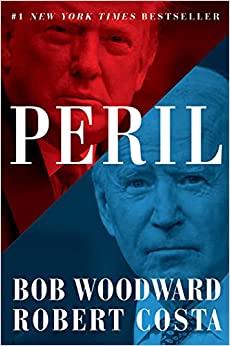
Trump & Co. had a five-point plan to undo the presidential election and overthrow the government. They sought to:
- Discredit and challenge state results (particularly in PA, GA, and AZ)
- Recruit the Department of Justice
- Draft Mike Pence
- Subvert the January 6th vote count
- Toss the election to the House of Representatives
The mob that stormed the Capitol on that fateful day in January was the spear’s edge of the assault.
The main features of these chilling designs are described in Peril, by Bob Woodward and Robert Costa.
It could have worked. And would have worked had the ever-loyal, browbeaten vice president succumbed and been “brave” as Trump had pressured him to by unilaterally declaring invalid Electoral College votes, at one point proffering a “wouldn’t-it-be-cool-to-have-that-kind-of-power” temptation. As proposed in a now infamous how-to memo on overthrowing the government devised by Trump lawyer John Eastman, the election, then, would have been decided in the House where the GOP holds a slim margin in state delegations.
Such an action would have undoubtedly precipitated a constitutional crisis with hitherto unthinkable consequences, including the employment of the Insurrection Act, martial law, and worse — a scenario adhering closely to the communist movement’s classic description of a key element in fascism’s ascent to power — the substitution of one state form of government by another.
“The accession to power of fascism is not an ordinary succession of one bourgeois government by another, but a substitution of one state form of class domination of the bourgeoisie — bourgeois democracy — by another form — open terrorist dictatorship,” wrote Georgi Dimitrov in his United Front: The Struggle against Fascism and War.
Those who continue to think the fascist danger overblown or mask it in classless, “authoritarian,” and “white nationalist” vagaries, would do well to consider that some closest to the process, while late in sounding the alarm, had no such misgivings about terminology. Why is this important? Because in battle, it’s vital to know who you’re fighting against and on what terrain to engage them. “Authoritarian white nationalism,” a bourgeois liberal term if there ever was one, tells us nothing about the class and social forces behind the Trump counterrevolution, in other words, who is footing the bills and pulling the strings. Fascism, on the other hand, as defined in Marxist terms points to banking and other capital as the chief culprits.
With respect to understanding what’s at stake, the alarmed Democratic Whip Jim Clyburn is described in Peril as “studying up on fascist histories with a focus on Italy. He saw Trump as America’s Benito Mussolini in waiting.”
 The book also relates a story told by Congressman Adam Smith of Washington State. Smith, who chairs the House Armed Services Committee, enjoyed the unhappy experience of boarding a commercial flight home filled with January 6th insurrectionists, several of whom spoke openly about something called 6MWE (6 million were not enough). Smith also shared the experience with Joint Chiefs chair Mark Milley in a phone conversation on January 8th. He later told colleagues, “My fear with Trump was always that he was going to engineer a fascist takeover of the country.”
The book also relates a story told by Congressman Adam Smith of Washington State. Smith, who chairs the House Armed Services Committee, enjoyed the unhappy experience of boarding a commercial flight home filled with January 6th insurrectionists, several of whom spoke openly about something called 6MWE (6 million were not enough). Smith also shared the experience with Joint Chiefs chair Mark Milley in a phone conversation on January 8th. He later told colleagues, “My fear with Trump was always that he was going to engineer a fascist takeover of the country.”
After January 6th, Milley, who later apologized after donning battle fatigues and joining Trump in the infamous Bible-toting walk across a Lafayette Square cleared by force, compiled a list of several fascist organizations that presented a clear and present danger to the Republic. On the list were 6MWE, Extreme Tea Party, QAnon, Patriot Movement, We the People Movement, Nazis, Proud Boys, Oath Keepers, NewsMax, and Epoch Times. As Woodward and Costa write: “Some were the new Brown Shirts, a U.S. version Milley concluded, of the paramilitary wing of the Nazi Party that supported Hitler. It was a planned revolution. Steve Bannon’s vision coming to life. Bring it all down, blow it up, burn it, and emerge with power.”
Bannon himself is reported to have told Trump, “We’re going to bury Biden on January 6th, fucking bury him.”
Even Trump’s CIA directors — people who know a thing or two about fascist coups — saw the danger. Secretary of State Pompeo, reacting to the Sidney Powell and Guilani team’s stewardship of Trump’s post-election legal fight, said, “The crazies are taking over.” The CIA’s Gina Haspel warned Milley, “We’re on the way to a right-wing coup.”
Importantly, Woodward and Costa mention a little-reported statement by the Joint Chiefs, joining the choir of those condemning January 6th. “The violent riot in Washington, D.C. on January 6, 2021 was a direct assault on the U.S. Congress, the Capitol building, and our Constitutional process,” the statement read. ““We witnessed actions inside the Capitol building that were inconsistent with the rule of law. The rights of freedom of speech and assembly do not give anyone the right to resort to violence, sedition and insurrection.”
The Joint Chiefs go on to say that the newly elected president “will” take office on January 20th.
Peril in over 400 pages relates, anecdotally, various episodes, intrigues, conspiracies, and policy debates leading up to and succeeding the 2020 election. This includes Biden’s Charlottesville-motivated decision to run against Trump, the Democratic campaign itself, and the new administration’s first months. In this regard, the book might be described as a paean to the Biden presidency and those who helped stave off a Trump coup, chief among them Milley, Clyburn, Nancy Pelosi, and even William Barr, Pompeo, and the former secretary of defense Mark Esper, the latter group of which might be voted the most unlikely to join “The Resistance.”
Yes, after shamelessly enabling, coddling, and defending Trump, key members of his administration seem to have broken with him as, to use Dimitrov’s phrase, the soon-to-be ex-president attempted to substitute one form of state power for another. Milley, in particular, is cast in a heroic light, standing up to Trump repeatedly, on debates ranging from attacking Iran to placing active-duty troops on U.S. streets during the mass democratic people’s uprising after George Floyd’s murder.
What led up to these ruptures, however, is anyone’s guess. And that’s where Peril fails as a journalistic history of the 2020 election. By focusing almost exclusively on the GOP’s and Democrat’s high command, the well-known class and social forces acting in both background and foreground are obscured from sight. The book does not consider, for example, to what degree the Chamber of Commerce’s decision to accept the election results influenced the actors, interventions by Wall Street, or even Fox News’ role, which is given little attention save Trump’s anger at their early call of the Arizona election for Biden.
As a moment in time, January 6th was much more than as Mike Pence recently termed it “a day in January.” Birthed on that same day was also the insurrection’s antithesis and remedy: the election of Raphael Warnock and Jon Ossoff in the great state of Georgia and the movement that made it happen. While mentioned in Peril, it’s done only in passing as the authors’ gaze remained fixated on high, missing almost completely what’s taking place at the grassroots — but then again that’s bourgeois journalism.
Still, there’s a lot revealed in Woodward and Costa’s treatment and many more threads to be unravelled, including an interesting tidbit about GOP strategy from House minority leader Kevin McCarthy who, when celebrating last November’s Congressional wins, remarked, “You know who I’m going to recruit? Small business owners. . . . They have a passion; they can see what abuse government can do to your own life.” Historically, small businesses, in country after country have been the mass base of fascist movements.
Thus as the country seeks to understand and defend itself against a present and ongoing fascist danger, Peril will be an important resource.
Image: Blink O’fanaye (CC BY-NC 2.0).


 Join Now
Join Now